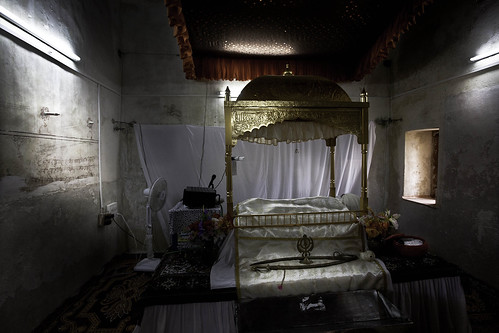Gurdwara Pehli Patshahi meaning the "Gurdwara of the first master" is situated at Lakhpat, Gujarat, India - A town in Gujarat, visited by Guru Nanak Sahib during his second and fourth missionary journeys (Udasis) in 1506-1513 AD and 1519-1521 AD respectively.
Gurdwara Guru Nanak Sahib has been built to preserve the memory of these visits of revered Guru during the early 1500s. Guru Nanak is believed to have visited this site while he was on his way to Mecca during the Fourth Udasi. A few rare personal possessions of his are retained here. The main room has relics associated with Guru Nanak Sahib, which relics, it is said, were bestowed by Guru Sahib to the Brahmin in whose house Guru Sahib stayed. These include Charan paduka -khdawans or wooden footwear and a Palki of the great Guru, both of which are housed in asealed glass enclosure, where there is Parkash of Guru Granth Sahib.
El Gurdwara (templo) Pehli Patshahi que significa "Gurdwara del primer
maestro" se encuentra en Lakhpat - Lakhpat recibió la visita de Gurú
Nanak Sahib, fundador de la religión Shij, durante su segundo y cuarto
viajes misioneros (Udasis) en 1506-1513 y 1519-1521 dC AD,
respectivamente. El Gurdwara Gurú Nanak Sahib se ha construido para
preservar la memoria de estas visitas del venerado Gurú que visitó este
sitio mientras se encontraba en su camino a la Meca durante la Udasi
Cuarto.
Gurdwara Guru Nanak Sahib has been built to preserve the memory of these visits of revered Guru during the early 1500s. Guru Nanak is believed to have visited this site while he was on his way to Mecca during the Fourth Udasi. A few rare personal possessions of his are retained here. The main room has relics associated with Guru Nanak Sahib, which relics, it is said, were bestowed by Guru Sahib to the Brahmin in whose house Guru Sahib stayed. These include Charan paduka -khdawans or wooden footwear and a Palki of the great Guru, both of which are housed in asealed glass enclosure, where there is Parkash of Guru Granth Sahib.
When the 1819 earthquake sent the Indus River on its present course
to the west and the Great Rann dried up, so did Lakhpat. It was left a
humble town around the ruins of its former grandness, now only with Kori
Creek that still flows into the Rann .Lakhpat and the area around is
very sparsely populated of not more than 400 persons. Though it
requires a long journey to reach Lakhpat, the intrepid traveler will be
rewarded. The 7 km fort walls, erected in 1801 by Jamadar Fateh
Muhammed, are still nearly intact, and offer tremendous views out over
the Rann.
In the course of Guru Nanak Dev ji's travels, he visited Gujarat and traveled on to Lakhpat. In old times, Lakhpat was part of Sind (now in Pakistan). Lakhpat is 170 kms from Gandhidham, Gujarat, India. In the sixteenth century Lakhpat was known as "Basta Bander". Lakhpat used to be a rich rice growing area and was also a popular port. However, due to an earthquake in 1819 A.D., the area became barren and crops withered away due to a lack of water as the river disappeared after the earthquake.
It is quite exceptional to be invited to take apicture of the place when you are not, obviously, a shij pilgrim..
-------------------------------------------------------------
Lakhpat es un pueblo fantasma de 400 habitantes. Antes llamado “La ciudad de los millonarios”. En los viejos tiempos, Lakhpat era parte de Sind (ahora en Pakistán). Lakhpat solía ser una zona rica en arroz de cultivo y también un puerto popular. Sin embargo, debido a un terremoto en 1819 dC, el área se convirtió en estéril y el río desapareció después del terremoto.
Algunas de sus posesiones personales se conservan aquí. La sala principal contiene reliquias que fueron otorgadas por Guru Sahib a los brahmanes, en cuya casa se quedó. Estos incluyen Charan Paduka-khdawans o el calzado de madera y un Palki del gran gurú, los cuales están alojados en una cubierta de cristal, donde hay Parkash de Guru Granth Sahib.
Cuando el terremoto de 1819 desvío el río Indo de su curso actual hacia el oeste el Gran Rann se secó al tiempo que lo hizo Lakhpat. Quedó un humilde pueblo en torno a las ruinas de su grandeza anterior, ahora sólo con Kori Creek que aún fluye en el Rann. Lakhpat y el área circundante es muy baja densidad de población de no más de 400 personas. A pesar de que requiere un largo viaje para llegar a Lakhpat, el intrépido viajero será recompensado. Los muros de 7 kilometros de la fortaleza, erigida en 1801 por jamadar Fateh Mohamed, siguen casi intactas, y ofrecen fantásticas vistas a lo largo del Rann (desierto) de Kutch.
Es excepcional que me invitaran a realizar una fotografía, obviamente no siendo un peregrino Shij, De hecho, el soldado me acompañó hasta la cama en la que durmió del hijo del Gurú Nanak decubriéndome las cortinas para que pudiera verla y fotografiarla.

